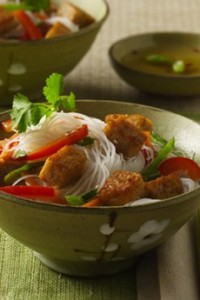TIP OF THE DAY: Asian-Style Pasta (It’s Called Noodles)
|
Pasta originated in China. Scholars credit the Chinese with making noodles from rice flour as early as 1700 B.C.E., the 17th century before the common era (or before Christ, if you still use the old system).
The pasta-centric Italians believe pasta dates back to the ancient Etruscans, who inhabited the Etruria region of Italy (the central-western portion of Italy, what now are Tuscany, Latium, and Umbria). They occupied the area from the Iron Age into Roman times (the 11th century B.C.E. to the 1st century B.C.E.). Around 400 B.C.E., the Etruscans began to prepare a very wide, lasagna-type noodle made of spelt, an early version of wheat. The Romans who followed made what they called lagane, a kind of lasagna, from a dough of water and flour. However, both the Etruscans and the Romans baked their noodles in an oven; boiled pasta had yet to be born in Italy. Here’s more on the history of pasta. But let’s circle back to Asia. What happened to pasta in that large region? It’s called noodles, and it’s plentiful. Different Asian cuisines developed different types of noodles; not just from wheat, as in Italy, but from other starches that happen to be gluten-free, such as rice, sweet potato, arrowroot starch, bean curd skin, potato starch, and tofu. You can feast on Asian noodle dishes in a splendid variety. |
|
|
|
ABOUT ASIAN NOODLES We’ve done our best to put together the list below. You may see some familiar names, but there are a lot of Asian noodle types to get to know. You can find them in Asian markets and of course, online. The one challenge is that there is no standardization. Spellings will vary by region, as will the width of the noodles. We’ve included analogous Italian pasta names to give you an approximate visual. Although they may look similar, Asian noodles and Italian pasta have key differences. Most pasta is designed to be cooked to an al dente texture, but Asian noodles vary widely: Some are meant to be eaten soft; others have a firm bite. Some are chewy, others are springy. A second difference: Italian pasta is boiled in water or broth (even baked pasta is boiled first). Chinese noodles can be boiled in water, cooked in soup or stir-fried. And third, unlike Italian pasta, most Asian noodle dishes do not have a sauce on top. If there’s a sauce, they are tossed in it. Asians also add noodles to salads, a treatment not typically found in the West. Unlike the short cuts developed in Italy (bowties, elbows, tube pasta, etc.), all Asian pasta is a strand or ribbon pasta. Finally, some Chinese noodles contain eggs, but the majority of Asian noodles do not. *They can be made from buckwheat, but also from potatoes and sweet potatoes. |
||
|
[2] Chicken Chow Mein, the way it should be (photo © Melissas.com. |
RECIPE: CHICKEN CHOW MEIN
Ingredients |
|
|
*†Substitute any cherry pepper or mild to medium chile. 1. COMBINE 1/4 cup soy sauce. 1 tablespoon hoisin sauce, 1 teaspoon oyster sauce, and chile and sesame oils in a large bowl. Add the chicken and cover the bowl with plastic wrap. Place in the fridge and let marinate, stirring often, for 1 hour. 2. PREPARE the noodles according to package directions. Rinse with cold water; drain. 3. PREHEAT the oven to 350°F. Heat 1 tablespoon peanut oil and the butter in a large wok or ovenproof skillet. Add the chicken and cook 2 minutes per side. Transfer to the oven and bake until the chicken is completely cooked through and a meat thermometer inserted into the thickest part reads 165°F, about 15 minutes. Cool the chicken until it can be handled, then shred it. 4. HEAT the remaining 2 tablespoons of peanut oil in a wok or large skillet over high heat. Add the mushrooms and cook, stirring occasionally, for 2 minutes. 5. ADD the garlic and the remaining 1/4 cup soy sauce, and the remaining hoisin and oyster sauces, the noodles, green onions, chiles and sugar snap peas. Cook, stirring constantly, until the vegetables are crisp-tender. 6. ADD the shredded chicken to the pan and cook until heated through. Stir in the salt and black pepper to taste. Serve. 1. COOL the cooked chicken until you can handle it; it should still be warm. Remove any skin. 2. USE one hand or a fork to steady the chicken. With the other hand, use a second fork to scrape and tear the flesh into shreds. When the fork gets clogged with chicken shreds, use your fingers or another fork to move them into a bowl. CHECK OUT WHAT’S HAPPENING ON OUR HOME PAGE, THENIBBLE.COM. |
||




